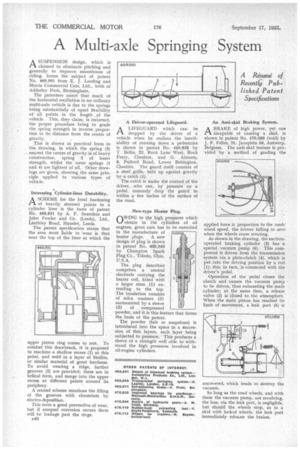A Multi-axle Springing System
Page 56

If you've noticed an error in this article please click here to report it so we can fix it.
ASUSPENSION design, which is claimed to eliminate pitching and generally to improve smoothness of riding, forms the subject of patent No. 469,991 from E. J. Leeding and Morris Commercial Cars, Ltd., both of Adderley Park, Birmingham.
The patentees assert that much of the horizontal oscillation in an ordinary multi-axle vehicle is due to the springs being substantially of equal flexibility at all points in the length of the vehicle. This, they claim, is incorrect, the proper procedure being to grade the spring strength in inverse proportion to its distance from the centre of gravity.
This is shown in practical form in the drawing, in which the spring (3) nearest the centre of gravity is of heavy construction, spring 2 of lesser strength, whilst the outer springs (1 and 4) are lightest of all. Other drawings are given, showing the same principle applied to various types of vehicle.
bicreasing Cylinder-liner Durability.
ASCHEME for the local hardening of heavily stressed points in a cylinder liner is the basis of patent No. 469,831 by A. F. Saunders and John Fowler and Co, (Leeds), Ltd., Leathley Road, Hunslet, Leeds.
The patent specification states that the area most liable to -wear is that near the top of the liner at which the
upper piston ring comes to rest. To combat this drawbrack, it is proposed to machine .a shallow recess (1) at this point, and weld in a layer of Stelae or similar material of great hardness. To avoid wearing a ridge, further grooves (2) are provided; these are in helical form, and merge into the upper recess at different points around its periphery.
A second scheme mentions the filling of the grooves with chromium by electro-deposition.
This seem a good preventive of wear, but if unequal corrosion occurs there will be leakage past the rings.
5411 A Driver-operated Lifeguard.
ALIFEGUARD which can be dropped by the driver of a vehicle when he realizes the inevitability of running down a pedestrian is shown in patent No. 469,828 by T Bells, 22, Rack Lane West, Rock Ferry, Cheshire, and G. Abrams, 8, Pulford Road, Lower Bebington, Cheshire. The guard itself consists of a steel grille, held up against gravity
by a catch (1). .
The catch is under the control of the driver, who can, by pressure on a pedal, instantly drop the guard to within a few inches of the surface of the road.
New-type Heater Plug.
(AWING to the high pressures which %--/ obtain in the cylinders of oil engines, great care has to be exercised in the manufacture of heater plugs. A new design of plug is shown in patent No. 469,848 by Champion Spark Plug Co., Toledo, Ohio, U.S.A.
The plug described comprises a central electrode carrying the heater coil, fitted with a larger stem ,(1) extending to the top. The insulation consists of mica washers (8) surmounted by a sleeve (2) of compressed powder, and it is this feature that forms the basis of the patent.
The powder (talc or soapstone) is introduced into the space in a 4ucces sion of thin layers, each layer being subjected to pressure. This produces a sleeve of a strength well able to withstand the high pressures involved in oil-engine cylinders. An Anti-skid Braking System.
ABRAKE of high power, yet one incapable of causing a skid, is shown in patent No. 470,089 (void) by J. F. Felies, St. Jansplein 56, Antwerp, Belgium, The anti-skid feature is provided by a method of grading the
applied force ir. proportion to the roadwheel speed, the former falling to zero when the wheels cease rotating.
As shown in the drawing, the suctionoperated braking cylinder (3) has a special vacuum pump (6). This component is driven from the transmission system via a plate-clutch (4), which is put into the driving position by a rod (1); this, in turn, is connected with the driver's pedal.
Operation of the pedal closes the clutch and causes the vacuum pump • to be driven, thus exhausting the main cylinder; at the same time, a release valve (2) is closed to the atmosphere. When the main piston has re.ar.bed its limit of movement, a leak port (5) is uncovered, which tends to destroy the vacuum.
So long as the road wheels, and with them the vacuum pump, are revolving, the loss, via the leak port, is negligible, but should the wheels stop, as in a skid with locked wheels, the leak port immediately releases the brakes.




















































































